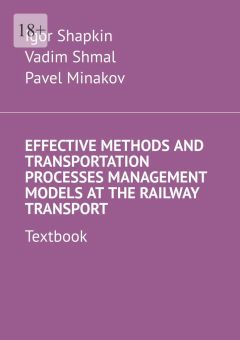Текст книги "Effective Methods and Transportation Processes Management Models at the Railway Transport. Textbook"

Автор книги: Igor Shapkin
Жанр: Прочая образовательная литература, Наука и Образование
Возрастные ограничения: +18
сообщить о неприемлемом содержимом
Текущая страница: 7 (всего у книги 11 страниц) [доступный отрывок для чтения: 2 страниц]
At the next step of the operational stage, the values of the predicted indicator distributed over intervals are recorded in the line of the experience array. In addition, the calculated values are recorded in the result array. Then, in a loop, the zone of the next indicator is read with its arrays and other data. The number of cycles is equal to the number of calculated indicators. After calculating all the predicted indicators, an array of results remains in RAM. Next, a printing program with the necessary regulatory and reference information is called to the random access memory.
Two modes should be implemented in the program for issuing results: regulatory and request. In the routine mode, the program in a certain order sends the results of the calculation to the workplaces of managers, i.e. to their workstations. Modular blanks are pre-formed to service requests. The user specifies the form of the response: print, screen, etc. This is where the operational stage ends.
When designing modern models for predicting the performance of complex control objects, they necessarily provide for elements of self-learning, self-correction and self-adjustment. In the system under consideration, a file of static data generated by the base computers at appropriate intervals is used for self-learning. The reporting database (RDB) is recorded in a computer, and the structure of the RDB is equivalent to the structure of the results array (RA). Next, the calculation program is called. The accuracy and completeness of the information is checked.
At the same time, it is clarified whether the decision-maker considers the work of the object of management over the past period to be satisfactory (if not, it introduces a prohibitive sign). In the process of trial operation, according to the decision-maker, the prohibitive sign is introduced by the operator. In the future, the decision-maker itself will fill out a certain message form, where it indicates the numbers of indicators that need to be assigned a prohibitive sign. And, finally, a machine check of the deviation of the forecast from the fulfillment of the indicator is carried out. If the deviation is greater than the predetermined value, then the prohibitive sign is assigned programmatically in the indicator line.
After that, the program for need to recalculate machine verification is turned on. The analysis of the trend coefficients is carried out. If their values are greater than the permitted ones, then a sign of the need to recalculate the reference data for this indicator is developed. The recalculation of the programs of the preparatory stage is carried out at non-operational times. Again, according to the «fresh» array of experience, long-term standards are recalculated, methods for selecting close situations are determined, etc. For this purpose, the zone of the «retrained» indicator is selected on a special carrier. After the recalculation, the updated information is recorded in its zone. Training of arrays of coefficients that take into account the peculiarities of periods and weather conditions is also carried out after receiving information about the indicators performed during the calculation period.
6 TRANSPORT PROCESSES SIMULATION
6.1 Train operation simulation at stations and sections of railways
At present, on the Russian railway network, forecast schedules designed for computers are widely used to plan train operation in operational conditions. However, the forecasting methodology in the existing programs is simplified and not accurate enough, since it uses rigidly defined time standards for performing various technological operations, and simplified decision-making algorithms are used when laying the threads of the schedule. In most cases, this is due to the fact that there is not enough initial information for reliable modeling of train work in dispatching areas and directions. Therefore, it is necessary to more clearly structure the initial data that are necessary for the development of a forecast schedule, in order to improve the quality of the forecast schedules obtained, taking into account the patterns of passing trains through sections, as well as the features of the technical equipment of specific lines. Moreover, it should be borne in mind that the development of the forecast should be carried out within an acceptable time frame in order to allow employees associated with operational management to take timely measures to mitigate or eliminate possible difficulties in work.
The proposed methodology for calculating the forecast schedule, as is known, differs from the existing one, first of all, in the preparation of the elements of the schedule. For this purpose, MIIT has developed and uses the method of multifactor situational and heuristic rationing (MSHR) of the duration of technological operations (train travel time on stretches, acceleration time, deceleration time, etc.).
The essence of the methodology lies in the fact that in order to increase the reliability of modeling the transportation process, i.e., for a more objective laying of trains, not averaged standards for the time spent on performing technological operations are used, but promptly calculated, taking into account not only the mass of the train, but the whole complex of influencing factors. To do this, an array of experience Z is organized, consisting of 50 rows for each element. The array stores the executed values of the factors Phi and the reporting time of operations. In particular, for each train, these are: the travel time for each section, and for each station – the acceleration and deceleration time and the time for performing operations with local trains. As soon as there is information about the departure of the train to the section or the forecast of departure, then the calculation of the distillation times of the course for all hauls, the acceleration and deceleration time and for all stations of the section using MSHR is promptly performed.
6.2 The essence of simulation modeling. Simulation modeling in management
Simulation method and its features. Static and dynamic representation of the simulated system.
Let us define the method of simulation modeling in its most general form as an experimental method for studying a real system according to its simulation model, which combines the features of the experimental approach and the specific conditions for the use of computer technology.
This definition emphasizes that simulation modeling is a machine method of modeling, in fact, it has never existed without a computer, and only the development of information technology has led to the formation of this type of computer modeling. This definition also focuses on the experimental nature of simulation, uses the simulation method of research (experimentation with the model is carried out). Indeed, in simulation modeling, an important role is played not only by the conduct, but also by the design of the experiment on the model. However, this definition does not clarify what the simulation model itself is. In this lecture, let’s try to figure out what the essence of simulation modeling is.
In the simulation process, the researcher deals with four main elements:
• Real system;
• Logical-mathematical model of the modeled object;
• Simulation (machine) model;
• The computer on which the simulation is carried out is a directed computational experiment.
The researcher studies the real system, develops a logical-mathematical model of the real system. The imitative nature of the study presupposes the presence of logical– or logical-mathematical models described by the process under study.
Above, we defined a real system as a set of interacting elements that function in time.
The peculiarity of simulation modeling is that the simulation model allows you to reproduce the simulated objects:
– with the preservation of their logical structure,
– with the preservation of behavioral properties (the sequence of alternation in time of events occurring in the system), i.e. dynamics of interactions.
In simulation modeling, the structure of the simulated system is adequately displayed in the model, and the processes of its functioning are played (simulated) on the constructed model. Therefore, the construction of a simulation model consists in describing the structure and processes of functioning of the simulated object or system. In the description of the simulation model, there are two components:
•A static description of the system, which is essentially a description of its structure. When developing a simulation model, it is necessary to perform a structural analysis of the simulated processes.
• Dynamic description of the system, or description of the dynamics of the interactions of its elements. When compiling it, it is actually necessary to build a functional model of simulated dynamic processes.
The idea of the method, from the point of view of its software implementation, was as follows. What if some software components are mapped to the elements of the system, and the states of these elements are described using state variables. Elements, by definition, interact (or exchange information), which means that an algorithm for the functioning of individual elements can be implemented – a modeling algorithm. In addition, elements exist in time, which means that you need to set an algorithm for changing state variables. Dynamics in simulation models are implemented using the mechanism of promotion of model time.
A distinctive feature of the simulation method is the ability to describe and reproduce the interaction between various elements of the system. Thus, in order to make a simulation model, it is necessary:
– to present a real system (process) as a set of interacting elements;
– algorithmically describe the functioning of individual elements;
– describe the process of interaction of various elements with each other and with the external environment.
The key point in simulation modeling is the isolation and description of the states of the system. A system is characterized by a set of state variables, each combination of which describes a specific state. Therefore, by changing the values of these variables, it is possible to simulate the transition of the system from one state to another. Thus, simulation modeling is the representation of the dynamic behavior of a system by moving it from one state to another in accordance with well-defined operating rules. These state changes can occur either continuously or at discrete points in time. Simulation modeling is a dynamic reflection of changes in the state of the system over time.
So, we figured out that in simulation modeling, the logical structure of a real system is displayed in the model, and the dynamics of the interactions of subsystems in the simulated system are simulated. This is an important, but not the only feature of the simulation model, which historically predetermined, not entirely successful, in my opinion, the name of the method, which serious researchers often call «system modeling».
The main stages of simulation modeling. General technological scheme.
Regardless of the type of models (continuous and discrete, deterministic and stochastic, etc.), simulation modeling includes a number of main stages, which is a complex iterative process:
1. Formulation of the problem and definition of the objectives of the simulation study The documented result at this stage is a meaningful description of the modeling object.
2. Development of a conceptual description. The result of the activity of a system analyst is a conceptual model (or verbal description) and the choice of a formalization method for a given modeling object.
3. Formalization of the simulation model. A formal description of the modeling object is compiled.
4. Programming of the simulation model (development of a simulator program). At the stage, the selection of modeling automation tools, algorithmization, programming and debugging of the simulation model is carried out.
5.Model test and research, model validation. Verification of the model, assessment of adequacy, study of the properties of the simulation model and other procedures for comprehensive testing of the developed model are carried out.
6. Planning and conducting a simulation experiment. At this technological stage, strategic and tactical planning of the simulation experiment is carried out. The result is a compiled and implemented experiment plan, the specified conditions of the simulation run for the selected plan.
7. Analysis of simulation results. The researcher interprets the simulation results and uses them – the actual decision-making.
Defining the objectives of the simulation study
At the first stage, the problem facing the researcher is formulated, and a decision is made on the advisability of using the simulation modeling method. The goals to be achieved as a result of the simulation are then determined. The choice of the type of simulation model and the nature of further simulation research on the simulation model largely depend on the formulation of goals.
At this stage, the object of modeling is determined and studied in detail, those aspects of its functioning that are of interest to the study. The result of the work at this stage is a meaningful description of the modeling object with an indication of the simulation goals and those aspects of the functioning of the modeling object that need to be studied on the simulation model. A meaningful description is compiled in the terminology of a real system, in the language of the subject area that is understandable to the customer.
In the course of compiling a meaningful description of the object of modeling, the boundaries of the study of the simulated object are established, a description of the external environment with which it interacts is given. The main performance criteria are also formulated, according to which it is supposed to compare various solutions on the model, the generation and description of the alternatives under consideration are carried out.
There is no general recipe for compiling a meaningful description. Success depends on the developer’s intuition and knowledge of the real system.
The general technology or sequence of actions at this stage is as follows: collecting data about the object of modeling and compiling a meaningful description of the object of modeling; This is followed by: the study of the problem situation – the definition of the diagnosis and the formulation of the problem; clarification of modeling goals; The necessity of modeling is substantiated and the choice of the modeling method is carried out. At this stage, the goals of modeling are clearly and specifically formulated. The objectives of the simulation define the overall design of the model and permeate all subsequent stages of simulation modeling; Next, the formation of a conceptual model of the object under study is carried out.
Let’s take a closer look at the main content of the activity of a system analyst at these early stages. This work is extremely important for all subsequent stages of simulation modeling, it is here that the simulation specialist demonstrates himself as a systems analyst who owns the art of modeling. The process by which a systems engineer or control scientist creates a model of the system under study can best be defined as an intuitive art. The art of modeling can be mastered by those who have original thinking, ingenuity, as well as deep knowledge of the systems that need to be modeled. When building models, we must rely on art, experience, intuition. The modern theoretical apparatus of system description cannot guarantee us that we perform the optimal modeling for our purposes. The study of specific model samples is not conducive to the development of a creative approach to creating models.
Structuring the original problem. Formulation of the problem. First of all, a systems analyst must be able to analyze the problem. It performs the study and structuring of the original problem, a clear formulation of the problem.
The analysis of the problem must begin with a detailed study of all aspects of functioning (it is important to understand the details here – therefore, you need to be an expert in a specific subject area or communicate closely with experts). The system under consideration is connected with other systems, therefore, from the standpoint of a systematic approach, it is necessary to unwind a tangle of problems: from the original formulation to expand to the problematics. It is important to set the tasks correctly. In this case, the general modeling task is divided into particular ones.
A systematic approach to problem solving involves:
• Systematic consideration of the essence of the problem:
– Substantiation of the essence and place of the problem under study;
– Formation of the general structure of the system under study;
– Identification of the full set of significant factors;
– Determination of functional dependencies between factors;
• Building a unified concept for solving the problem:
– Study of objective conditions for solving the problem;
– Justification of goals, tasks necessary to solve the problem – structuring of tasks, formalization of goals;
– Development of tools and methods for solving the problem: description of alternatives, scenarios, decisive rules and control actions for further development on the model of decision-making procedures;
• Systematic use of modeling methods:
– System classification (structuring) of modeling problems;
– System analysis of the capabilities of modeling methods;
– Selection of effective modeling methods.
Identification of goals. The first and most important step in creating any model is to determine its intended purpose. Goals are the antipodes of the problem. The method of decomposition of goals can be applied, which involves dividing the whole into parts: goals into subgoals, tasks into subtasks. In practice, this approach leads to hierarchical tree structures (building a goal tree). This whole procedure is the lot of experts on the problem, specialists. Therefore, there is a subjective factor here, each expert will do it in his own way. The practical problem is how fully everything is structured. (The goal tree built as a result of this procedure may later be useful in the formation of many criteria).
What pitfalls await a novice systems analyst? The fact that for one level the goal is for another means, they are often confused, there is a confusion of goals. The goal is a description of the desired future, so it is easy to make a mistake here. For a complex system with a large number of subsystems, the goals may be contradictory. The goal is rarely the only one: there is a danger of incorrect ranking with many goals.
The modeling goals formulated and structured at the first stage permeate the entire course of further simulation research.
Let’s consider the most common categories of goals in a simulation study: evaluation, forecasting, optimization, comparison of alternatives, etc.
Simulation experiments are conducted for a wide variety of purposes, which may include:
• Evaluation – determining how well the system of the proposed structure will meet some specific criteria,
• Comparison of alternatives – comparison of competing systems designed to perform a specific function, or to compare several proposed working principles or methods,
• Forecast – an assessment of the behavior of the system under some expected combination of operating conditions,
• Sensitivity analysis – identification of a large number of active factors those that most affect the overall behavior of the system,
• Identification of functional relationships – determining the nature of the relationship between two or more acting factors, on the one hand, and the response of the system, on the other,
• Optimization – the exact definition of such a combination of acting factors and their values, which ensures the best response of the entire system as a whole.
Formation of criteria. A clear and unambiguous definition of the criteria is crucial. This affects the process of creating and experimenting with the model, in addition, the incorrect definition of the criterion leads to incorrect conclusions. There are criteria by which the system assesses the degree of achievement of the goal, and criteria by which the way to move towards the goal (or the effectiveness of the means to achieve the goals) is evaluated. For multi-criteria modeled systems, a set of criteria is formed, they must be structured by subsystems or ranked by importance.









































